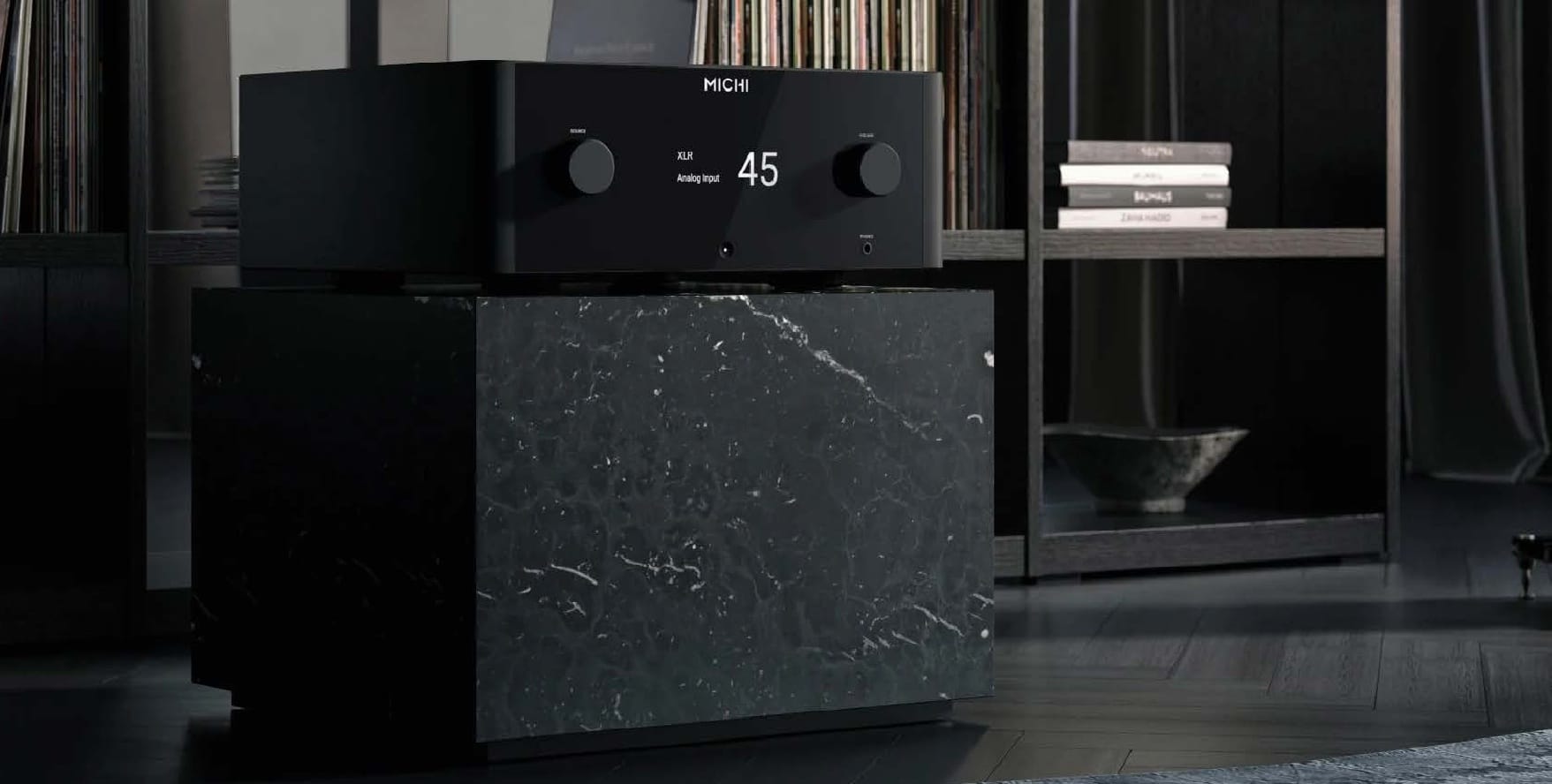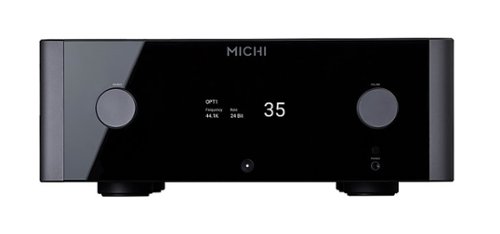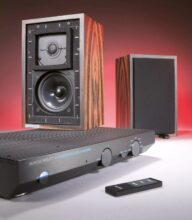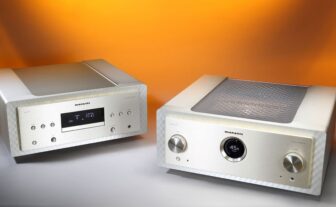ROTEL MICHI X5 S2 Review
Rotel’s Michi series took us by storm – and the updated X5 is one of the best buys in the high-end class.
Saying we were surprised would be an understatement. When we tested Rotel’s new Michi series in 2020, we were almost floored with pure joy. First, we were completely caught off guard that Rotel even revived the Michi series, which once consisted of a complete lineup of electronics, including a 2×200-watt power amplifier, though oddly enough, no integrated amplifier.
It would take 20 years for the Michi name to grace the front of an integrated Rotel amplifier. And not just one, but two models: X3 and X5.
The flagship Rotel Michi X5 was a 350-watt, over 40-kilogram beast, and perhaps the best buy among all integrated amplifiers in its class at the time.
Last year, in 2023, Rotel released updated versions of the Michi series. Featuring the same massive design introduced with the new Michi series in 2019, but with a significant number of internal changes. In fact, there are more than 90 changes in the X5 Series 2, according to Rotel. They also replaced the AKM DAC with a new eight-channel 32-bit DAC from ESS, called the ES 9028PRO.

As if that wasn’t enough, Rotel also modified the surrounding circuits to eliminate interference and further lower the noise floor. The new Series 2 delivers, again according to Rotel, a more precise, tighter, and more open soundstage than before, luckily with the same massive dynamics and insane punch down to sub frequencies.
DAC – BUT NO STREAMING
The X5 Series 2 is an integrated amplifier that lacks little, but it does not have built-in Wi-Fi, so streaming must be done via Bluetooth ACC and aptX HD. I’d bet that anyone buying an X5 Series 2 will stream music over the network to a separate streamer, such as one from Lumin, Hi-Fi Rose, or Auralic.
On the back, you’ll find all the inputs for the DAC, meaning USB for a wired connection to a computer with Tidal, Spotify, or Qobuz, three optical and three coaxial digital inputs. There’s also a balanced input for analog signals, four line inputs, and one for a turntable, either with MM or MC cartridge. And both a pre-out and a subwoofer output.

So, most things are in place. Including Roon support.
Under the hood, if you know where to look, you’ll find four 22,000 μF capacitors, and dual transformers dividing the amplifier’s output stage in a so-called dual mono configuration. The amplifier easily delivers 350 watts per channel into 8 ohms, or up to 600 watts per channel into 4 ohms. There aren’t many integrated amplifiers in this class that match the X5 Series 2 in raw power.
Those who like to relax in a chair with a pair of headphones will appreciate that the amplifier also has a headphone output on the front.
In the middle of the front is a display that can be configured to show the selected input, volume, VU meters, or a spectrum analysis of the signal. The included remote control has a settings button where you can adjust various parameters, such as renaming the inputs.
The price has gone up since the last version, partly because Rotel spent more on the internal components, increasing production costs. And partly because currency exchange rates have changed significantly since the Michi series was introduced in 2019 – unfortunately, not in favor of us consumers.
ALTERNATIVES TO X5 SERIES 2
The new Michi Series 2 also consists of a preamplifier and two power amplifiers. One stereo and one mono version. But the X3 Series 2 comes closest to the X5 Series 2. They are almost identical, with the same analog and digital inputs and the ESS DAC. They support the same audio formats – including MQA – as the preamplifier P5 Series 2.
The Michi X3 Series 2 only has a phono input for MM cartridges, whereas the Michi X5 series also has an MC input. The smaller X3 Series 2 delivers slightly less power but is still a potent powerhouse with 200 watts into 8 ohms and 350 watts into 4 ohms.
So if you don’t need as much power as the X5 Series 2 can deliver – or the MC input – the X3 Series 2 could be the smart choice. You’ll save $1,800, which isn’t exactly pocket change.
Neither of the two amplifiers lacks competitors in their respective price classes. The McIntosh MA5300 costs a bit more than the X5 Series 2 and has similar features, but lower power at 100 watts per channel. The Hegel H400 is a more direct competitor. It’s $1,000 cheaper and has streaming via Ethernet, but lacks a phono input. Still, it’s a natural comparison, and surely an amplifier many will consider as an alternative to the X5 Series 2. Or the X3 Series 2, for that matter.
ENORMOUS SOUNDSTAGE AND EXTREME DYNAMICS
The amplifier’s built-in digital converter is not worse than the one in the H400 or the DAC module in the McIntosh C55 – as well as the MA9500, MA1200, and more. You’d need very specific requirements to justify spending a month’s salary on an external DAC. The same goes to some extent for the phono input. The sound quality isn’t as refined and focused as the phono input on the C55, but it’s on par with what you get from the phono input on the Yamaha A-S3200.
A direct comparison with the A-S3200 was interesting in many ways. Sure, the Rotel amplifier has unsurprisingly better control – especially in the bass – when played loudly, but that’s also the most significant sound difference. It’s not that they sound the same otherwise, but on speakers like the Focal Scala Utopia EVO – meaning larger speakers than, for example, Audiovector R3 Arreté, Sonus faber Olympica Nova III, or KEF R7 Meta – the Rotel amplifier will provide better control over the speakers regardless of volume.
We tested the Rotel amplifier on the aforementioned Focal Scala Utopia EVO, and my colleague Geir was highly impressed:
– Rotel Michi X5 S2 has impressive control over the Scala Utopia EVO. That an amplifier for $8,100 can master speakers costing half a million is both surprising and admirable.
It should also be noted that the Hegel H400 wouldn’t have had much trouble controlling the Scala Utopia EVO either. It’s not significantly less potent than the Rotel amplifier, even though it doesn’t have quite the same power deep in the sub-bass range as the X5 Series 2.
– James Blake’s “Limit To Your Love” makes the deep bass vibrate through the room while the Michi X5 S2 keeps the delicate vocals in check. Such power, such control! Geir exclaims but adds:
– Compared to the Hegel H600, the Michi X5 S2 is not lagging. This is a complete package that delivers high-end performance at a more affordable price.
Bold words. The H600 is a much more expensive amplifier, and in practice, it’s the one that’s comparable to the Rotel amplifier.
With the Sonus faber Olympica connected to the Rotel amplifier, it didn’t take many notes into Jan Gunnar Hoff’s “Within” from the vinyl album *Polarity* before I noticed the amplifier brought out the phrasing in Anders Jomin’s bass in a way I rarely hear. Audun Kleive’s percussion adds a soft beat at the bottom, but the rhythm is driven by the bass. It sounds so close and intimate that I imagine I can touch it if I just stretch out my hand.
There’s a realism in how the music is presented that is anything but clinical. The enormous soundstage could perhaps be more focused, compared to the McIntosh MA12000 or Naim’s Classic 300 series – both much more expensive – but there’s no lack of grip or dynamic contrast.
The sound from the guitar on Hans Theessink’s acoustic version of “Sympathy For The Devil” is presented with a force and dynamic that almost takes my breath away. The volume is so high that I can barely hear myself think, but the music is crystal clear in the huge soundstage that envelops the room. There isn’t a moment where the amplifier loses control. Not even when Chris Farlowe and The Thunderbirds kick off “All The Way Lover.”
The sound from the Rotel amplifier isn’t just about steel control and dynamics. It also has a warmth that dresses the music and creates more realism in the soundstage. This applies to everything from piano tones, which get a deep and rich foundation, to vocals that grow in scope and depth.
If we have to point out anything, it would be that there’s greater detail and finesse in more expensive amplifiers. But then you’d have to pay a lot more. In this price range, it’s hard to find a better buy among integrated amplifiers.

SPECS
Type: Integrated amplifier
Power: 2 x 350 watts into 8 ohms, 2 x 600 watts into 4 ohms
Technology: Transistor
Connections: 4 unbalanced RCA, XLR in, pre out, USB-B, coaxial digital, 3 optical/coaxial
Phono input: Moving Magnet, Moving Coil
DAC: ESS Sabre ES 9028PRO 32 bit/768 kHz
Network: Bluetooth aptX HD with AAC, Ethernet
Frequency range: 10–100,000 Hz
Headphone jack: 6.3 mm
Dynamics: No data
THD: 0.009%
Signal/noise: 120 dB
Other: OLED display, remote control, Roon tested
Dimensions/weight: 48.5 x 19.5 x 45.2 cm/43.8 kg

CONCLUSION
The Michi X5 Series 2 is darn good for being an all-in-one integrated amplifier. It may lack the very last nuances you get from more expensive separate components, but the overall package is extremely impressive, Geir concludes.
When you purchase through links on our site, I may earn an affiliate commission. Here’s how it works.
MICHI X5 Series 2 Beauty Shots
The Michi X5 Series 2 Integrated Amplifier is authoritative and precise, capable of delivering a speaker-taming 600 watts of Class ...








